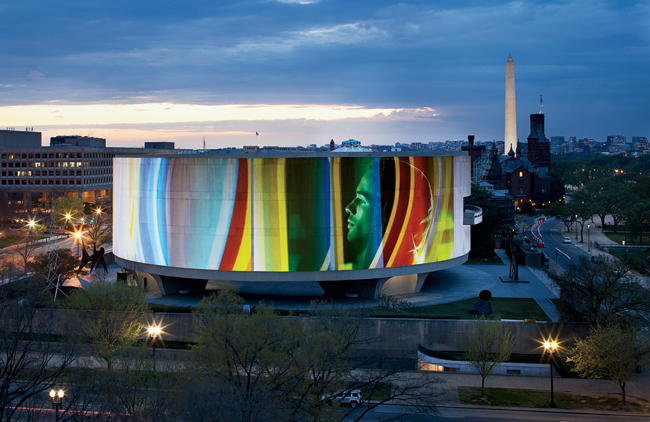Washington, D.C.

|
|
Photo: © Frederick Charles
|
Capital Improvement
Artist Doug Aitken first visited the Hirshhorn Museum and Sculpture Garden in 2009, on the invitation of its director Richard Koshalek to conceive an entirely mirrored reading room in the lower lobby. Aitken had barely stepped out of the taxi before turning the creative brief inside-out. When he saw the curvy building on the National Mall'a hollow cylinder raised on four piers designed by Gordon Bunshaft and completed in 1974'Aitken recalls, 'My mind raced to the other side of the spectrum: If we have this phenomenal building that's very monolithic in its form and structure, then can we make it almost liquid architecture?'
The result of his musing is Song 1, a series of musical vignettes, for which Aitken projects high-definition video on the entirety of the Hirshhorn's precast concrete facade, a surface measuring 82 feet high and 725 feet around its circumference. The total image size is 1,080 pixels tall by 13,444 pixels wide and requires 11 high-definition video projectors to achieve full coverage of the building elevation. Song 1 is said to be the first 360-degree convex projection in cinematic history.
In each of his works, Aitken notes, he tries to distill a concept to its minimum, so viewers can interpret a piece according to personal experience. Song 1 features a polyglot cast'from actor Tilda Swinton and musician John Doe to a woman Aitken encountered on the sidewalk'each performing, or performing to, one of 40 new versions of the 1934 standard 'I Only Have Eyes for You.' Filmed in what the artist calls 'the places we pass by,' such as short-order kitchens, factories, and cars, the performances and generic backdrops could be understood as narratives or abstractions.
As the sky darkens, these scenes brighten and the facade's pink-granite aggregate appears less textural. A scene can encompass the entire building, or multiple images section it into frames. Three real-time, media-compositing Quad HD video servers send content to the projectors via 41,500 feet of fiber-optic cable. Because each projector is capable of creating a 1,080-by-1,920-pixel image, the source material was edited into 11 components and arranged so that additional pixels overlap for visual continuity. Prior to opening, technicians aligned the 160-pound projectors encircling the building according to that digital editing, then calibrated the image to its curvature.
'There is an invisible rhythm to the way the light moves, the way the edits transpire,' Aitken says of the final product. Because the scenes in Song 1 include rotation and upward movement, the installation gives the impression that the building itself is spinning, or at least evokes the carousel service that has been installed in front of the Smithsonian's Arts and Industries Building since 1967.
'We call it curating public space,' museum director Koshalek says. 'Artists have to play a larger role in society, and they cannot be limited to isolated situations.' Aitken's site-specific project animates a central section of the city, that is safely illuminated, but eerily inactive, after dusk. Joggers and bicyclists, caught by surprise, break from their exercise routines to mill around the contemporary cyclorama.
Koshalek also calls the nighttime scene a step toward repositioning the museum as an active player in cultural policy making, because, besides grabbing the attention of passersby, the temporary beacon provokes dialogue. It questions the internal meditations and public interactions that Americans want their urban plazas to achieve. (Song 1 runs through May 13th.)
People
Artist:
Client:
Consultants:
Size:
Completion Date: |
Products
Technical Equipment: |



Post a comment to this article
Report Abusive Comment